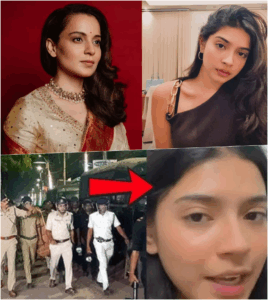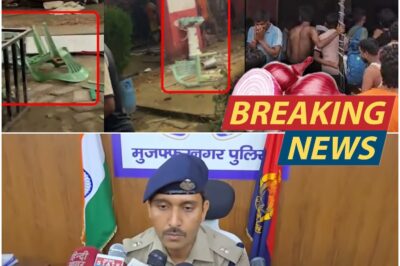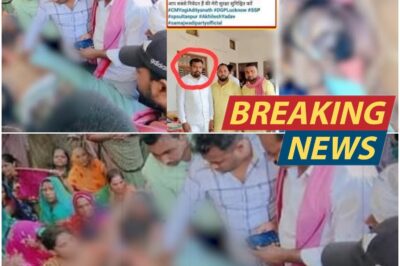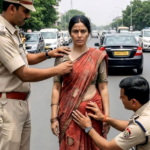Law Student Arrested: The Controversy That Shook Social Media and Sparked National Debate
In a country as diverse and sensitive as India, where religion plays a significant role in the public consciousness, even a single comment can spark a wildfire of controversy. This is exactly what happened when Sharmistha Panoli, a young law student, found herself at the center of a national storm after her remarks on Islam and the Prophet became the subject of widespread outrage. What began as a seemingly innocuous Instagram post soon spiraled into a legal case, a social media frenzy, and a heated debate on the limits of free speech in a democratic society.
This is the story of how one video changed Sharmistha’s life forever, shook the nation, and reignited discussions about freedom of expression, religious sensitivity, and the power of social media.
.
.
.

The Incident: A Video That Went Viral
It all started when Sharmistha Panoli, a law student with a promising future, posted a video on Instagram. In the video, she allegedly made remarks that were considered offensive to Islam and the Prophet. The video also contained comments about “Operation Sindoor,” a controversial topic that further fueled the backlash. While the exact content of the video remains undisclosed, police sources claim that it targeted a specific religion and contained derogatory remarks that hurt the sentiments of the Muslim community.
The video quickly gained traction, spreading like wildfire across social media platforms. Within hours, it went viral, drawing sharp criticism from people across the country. While some defended her right to free speech, the majority condemned her comments as inflammatory and disrespectful. By the time Sharmistha deleted the video, the damage had already been done. The video had been widely shared, leading to a public outcry and calls for legal action against her.
The Backlash: Outrage Across Social Media
As the video circulated, social media platforms became battlegrounds for heated debates. Hashtags like #ArrestSharmistha and #JusticeForSharmistha began trending, with users divided in their opinions. On one side were those who demanded strict action against her, arguing that her remarks were not only offensive but also a threat to communal harmony. On the other side were those who defended her, claiming that her comments, while controversial, fell within the bounds of free speech.
“The video was deeply hurtful and disrespectful,” said one social media user. “In a country as diverse as India, we cannot allow such comments to go unchecked.”
Another user countered, “While her remarks may have been inappropriate, arresting her is excessive. We live in a democracy where people should be free to express their opinions, even if they are unpopular.”
The outrage was not limited to social media. Protests were reported in several cities, with people demanding her arrest. Religious leaders and community organizations also weighed in, calling for strict legal action to set an example and prevent such incidents in the future.
The Legal Action: From Complaint to Arrest
As the public outcry grew, a formal complaint was lodged at a police station in Kolkata. The complainant alleged that Sharmistha’s video violated several sections of the Indian Penal Code, including those related to hate speech and hurting religious sentiments. Based on the complaint, an FIR (First Information Report) was registered, and an investigation was launched.
According to police sources, multiple attempts were made to contact Sharmistha and her family. Legal notices were sent, but they reportedly went unanswered. The police also visited her residence, but she was allegedly untraceable. After failing to establish contact, the authorities sought and obtained an arrest warrant from the court.
Sharmistha was eventually arrested from Gurugram, Haryana, in a dramatic operation that drew significant media attention. Her arrest marked a turning point in the case, reigniting the debate on social media and sparking fresh discussions about the role of law enforcement in such matters.
The Apology: A Plea for Forgiveness
Before her arrest, Sharmistha issued an unconditional apology on social media. In her statement, she expressed deep regret for her remarks and clarified that they were her personal views, not intended to offend anyone.
“I sincerely apologize for any hurt caused by my remarks,” she wrote. “These were my personal opinions, and I never intended to harm anyone’s sentiments. If my words have caused pain, I deeply regret it and promise to be more cautious in the future. Please accept my apology.”
Despite her apology, the backlash continued. While some accepted her apology and called for leniency, others argued that her remarks had already caused significant harm and that an apology was not enough.
The Debate: Freedom of Speech vs. Responsibility
Sharmistha’s case has sparked a larger debate about the balance between freedom of speech and the responsibility to avoid offending others. India’s Constitution guarantees the right to free speech, but it also imposes reasonable restrictions to prevent hate speech and maintain public order. This case has highlighted the fine line between expressing one’s opinions and crossing into the territory of hate speech.
Supporters of Sharmistha argue that her arrest is an overreaction and sets a dangerous precedent. “She made a mistake, apologized, and should be given a chance to learn from it,” said a senior lawyer. “Arresting her for expressing her opinions, even if they were controversial, is a step backward for democracy.”
Critics, however, argue that her remarks were not just a mistake but a deliberate attempt to provoke. “Freedom of speech does not mean freedom to hurt others,” said a community leader. “Her comments were deeply offensive and could have incited communal tensions. Legal action was necessary to send a message that such behavior will not be tolerated.”
The Role of Social Media: A Double-Edged Sword
Sharmistha’s case has also highlighted the power and pitfalls of social media. Platforms like Instagram and Twitter have given individuals a voice, allowing them to express their opinions and reach a global audience. However, they have also become breeding grounds for outrage and polarization.
In this case, social media played a dual role. On one hand, it amplified the controversy, turning a single video into a national issue. On the other hand, it provided Sharmistha with a platform to apologize and explain her actions. The incident serves as a reminder of the responsibility that comes with using social media and the potential consequences of a single post.
What Lies Ahead for Sharmistha?
As of now, Sharmistha remains in police custody, and the investigation is ongoing. Legal experts believe that the case could take months to resolve, depending on the evidence presented and the charges filed against her. If convicted, she could face significant legal penalties, including imprisonment.
However, many believe that this case should serve as a lesson rather than a punishment. “She’s a young student with her whole life ahead of her,” said a professor from her law school. “Instead of ruining her future, we should focus on educating her and others about the importance of responsible speech.”
Play video:
Conclusion: A Cautionary Tale
The arrest of Sharmistha Panoli has become a flashpoint in the ongoing debate about freedom of speech, religious sensitivity, and the role of social media in modern society. While her remarks were undoubtedly controversial, her case raises important questions about the limits of expression, the consequences of public outrage, and the role of the legal system in addressing such issues.
As the nation waits to see how the case unfolds, one thing is clear: the incident has sparked a much-needed conversation about the responsibilities that come with freedom of speech in a diverse and democratic society. Whether Sharmistha’s arrest was justified or excessive remains a matter of debate, but her story serves as a cautionary tale for anyone navigating the powerful and often unpredictable world of social media.
News
Missing PG Student Monica from Darbhanga CM College Found in Shocking Condition—Police Stunned
Missing Darbhanga CM College Student Monica Found Safe—Reveals She Left Home Willingly to Marry A week-long mystery surrounding the disappearance…
Chaos on the Kanwar Yatra: Devotees Go on Rampage, Vandalize Dhaba from Muzaffarnagar to Roorkee!
Kanwar Yatra Turns Violent: Kanwariyas Vandalize Dhabas from Muzaffarnagar to Roorkee Over Onion in Food A shocking wave of violence…
Uproar After Samajwadi Party Leader Sunil Yadav’s Death: Ex-MLA and Brother-in-Law Named in FIR!
Uproar in Sultanpur After Samajwadi Party Leader Sunil Yadav’s Mysterious Death: Former MLA and Brother-in-Law Named in FIR A wave…
Shocking Viral Video: Teacher Beats Student with Stick in Bihar School—Discipline or Violence?
Bihar School Turns Battleground: Viral Video Shows Teacher Beaten Brutally by Angry Parents—Discipline or Violence? A shocking video has taken…
Forced to Strip at Knifepoint: Obscenity in the Name of Jobs—What’s Happening in Uttar Pradesh?
Job Promise Turns Nightmare: Woman Forced to Undress at Knifepoint in Uttar Pradesh Official’s Quarters Uttar Pradesh: A shocking video…
UP Education Minister Injured in Road Accident as Convoy Cars Collide
UP Education Minister Gulab Devi Injured in Road Accident as Convoy Cars Collide Hapur, Uttar Pradesh: Uttar Pradesh’s Education Minister,…
End of content
No more pages to load










